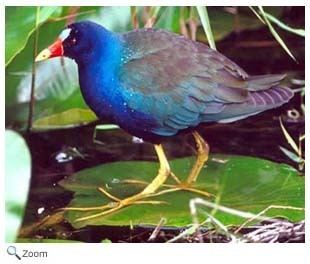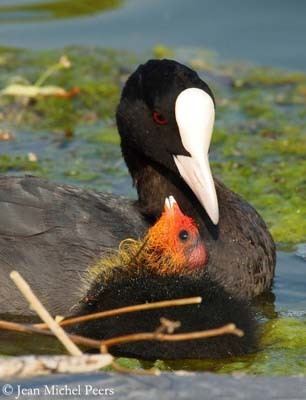Kingdom Animalia Higher classification Gruiformes Rank Family Subclass Modern birds | Scientific name Rallidae Phylum Chordata Order Gruiformes | |
 | ||
Lower classifications Coot, Common moorhen, Moorhen, Water rail, Porzana | ||
The rails, or Rallidae, are a large cosmopolitan family of small- to medium-sized ground-living birds. The family exhibits considerable diversity and also includes the crakes, coots, and gallinules. Many species are associated with wetlands, although the family is found in every terrestrial habitat except dry deserts, polar regions, and alpine areas above the snow line. Members of the Rallidae occur on every continent except Antarctica. There are numerous island species. The most common rail habitats are marshland or dense forest. They are especially fond of dense vegetation.
Contents
- Coot walking on ice january 28 2016 21
- Morphology
- Flight and flightlessness
- Behaviour and ecology
- Reproduction
- Rallidae and humans
- Threats and conservation
- Systematics and evolution
- Extant living genera
- Phylogeny
- Recently extinct genera
- Late Quaternary prehistoric extinctions
- Fossil record
- Doubtfully placed here
- References

Coot walking on ice january 28 2016 21
Morphology

The rails are a fairly homogeneous family of small to medium-sized, ground-living birds. They vary in length from 12 cm to 63 cm and in weight from 20 g to 3000 g. Some species have long necks and in many cases are laterally compressed.

The bill is the most variable feature within the family. In some species it is longer than the head (like the clapper rail of the Americas), in others it may be short and wide (as in the coots), or massive (as in the purple gallinules). A few coots and gallinules have a frontal shield, which is a fleshy, rearward extension of the upper bill. The most complex frontal shield is found in the horned coot.
Rails exhibit very little sexual dimorphism in either plumage or size.
Flight and flightlessness

The wings of all rails are short and rounded. The flight of those Rallidae able to fly, while not powerful, can be sustained for long periods of time, and many species migrate annually. The weakness of their flight, however, means they are easily blown off course and thus are common vagrants, a characteristic that has led them to colonize many isolated oceanic islands. Furthermore, these birds often prefer to run rather than fly, especially in dense habitat. Some are also flightless at some time during their moult period.

Flightlessness in rails is one of the best examples of parallel evolution in the animal kingdom. Of the ~150 historically known rail species, 31 extant or recently extinct species evolved flightlessness from volant ancestors. This process created the endemic populations of flightless rails that we see on Pacific islands today.
Many island rails are flightless because small island habitats without mammalian predators eliminate the need to fly or move long distances. Flight makes intense demands, with the keel and flight muscles taking up to a quarter of a bird's weight in flying Rallidae species. Reducing the flight muscles, with a corresponding lowering of metabolic demands, reduces the flightless rail's energy expenditures. For this reason, flightlessness makes it easier to survive and colonize an island where resources may be limited. This also allows for the evolution of multiple sizes of flightless rails on the same island as the birds diversify to find niches.
In addition to energy conservation, certain morphological traits also affect rail evolution. Rails have relatively shortened wings to begin with, which, in combination with their terrestrial habits and behavioral flightlessness, lends speed to the evolution of flightlessness, making it remarkably fast; it took as little as 125,000 years for the Laysan rail to lose the power of flight and evolve the reduced, stubby wings only useful to keep balance when running quickly. Indeed, some argue that it might be possible to measure the evolution of flightlessness in rails in generations rather than millennia.
Another factor that contributes to the occurrence of the flightless state is a climate that does not necessitate seasonal long-distance migration; this is evidenced by the tendency to evolve flightlessness at a much greater occurrence in tropical islands than in temperate or polar islands.
It is paradoxical, since rails appear loath to fly, that the evolution of flightless rails would necessitate high dispersal to isolated islands. Nonetheless, three species of small-massed rails, Gallirallus philippensis, Porphyrio porphyrio, and Porzana tabuensis, exhibit a persistently high ability to disperse long-distance among tropic Pacific islands, though only the latter two gave rise to flightless endemic species throughout the Pacific Basin. In examining the phylogeny of G. philippensis, it becomes clear that although the species is polyphyletic, it is not the ancestor of most of its flightless descendants, revealing that the flightless condition evolved in rails before speciation was complete.
A consequence of lowered energy expenditure in flightless island rails has also been associated with evolution of their "tolerance" and "approachability". For example, the (non-Rallidae) Corsican blue tits exhibit lower aggression and reduced territorial defense behaviors than do their mainland European counterparts, but this tolerance may be limited to close relatives. The resulting kin-selecting altruistic phenomena reallocates resources to produce fewer young that are more competitive and would benefit the population as an entirety, rather than many young who would exhibit less fitness. Unfortunately, with the human occupation of most islands in the past 5,000 to 35,000 years, selection has undoubtedly reversed the tolerance into a wariness of humans and predators, causing species unequipped for the change to become susceptible to extinction.
Behaviour and ecology
In general, members of Rallidae are omnivorous generalists. Many species eat invertebrates, as well as fruit or seedlings. A few species are primarily herbivorous. The calls of Rallidae species vary and are often quite loud. Some are whistle-like or squeak-like, while others seem un-birdlike. Loud calls are useful in dense vegetation, or at night where it is difficult to see another member of the species. Some calls are territorial.
The most typical family members occupy dense vegetation in damp environments near lakes, swamps, or rivers. Reed beds are a particularly favoured habitat. They are omnivorous, and those that migrate do so at night.
Most nest in dense vegetation. In general, they are shy, secretive, and difficult to observe. Most species walk and run vigorously on strong legs, and have long toes that are well adapted to soft, uneven surfaces. They tend to have short, rounded wings and although they are generally weak fliers, they are, nevertheless, capable of covering long distances. Island species often become flightless, and many of them are now extinct following the introduction of terrestrial predators such as cats, rats and pigs.
Many reedbed species are secretive (apart from loud calls), crepuscular, and have laterally flattened bodies. In the Old World, long-billed species tend to be called rails and short-billed species crakes. North American species are normally called rails irrespective of bill length. The smallest of these is the Swinhoe's rail, at 13 cm (5.1 in) and 25 grams. The larger species are also sometimes given other names. The black coots are more adapted to open water than their relatives, and some other large species are called gallinules and swamphens. The largest of this group is the takahē, at 65 cm (26 in) and 2.7 kg (6.0 lb).
The rails have suffered disproportionally from human changes to the environment, and it is estimated that several hundred species of island rail have become extinct because of this. Several island species of rail remain endangered, and conservation organisations and governments continue to work to prevent their extinction.
Reproduction
The breeding behaviors of many Rallidae species are poorly understood or unknown. Most are thought to be monogamous, although polygyny and polyandry have been reported. Most often, they lay five to ten eggs. Clutches as small as one or as large as fifteen eggs are known. Egg clutches may not always hatch at the same time. Chicks become mobile after a few days. They often depend on their parents until fledging, which happens at around one month.
Rallidae and humans
Some larger, more abundant rails are hunted and their eggs collected for food. The Wake Island rail was hunted to extinction by the starving Japanese garrison after the island was cut off from supply during World War II. At least two species, the common moorhen and the American purple gallinule, have been considered pests.
Threats and conservation
Due to their tendencies towards flightlessness, many island species have been unable to cope with introduced species. The most dramatic human-caused extinctions occurred in the Pacific Ocean as people colonised the islands of Melanesia, Polynesia and Micronesia, during which an estimated 750–1800 species of bird became extinct, half of which were rails. Some species that came close to extinction, such as the Lord Howe woodhen, and the takahē, have made modest recoveries due to the efforts of conservation organisations. The Guam rail came perilously close to extinction when brown tree snakes were introduced to Guam, but some of the last remaining individuals were taken into captivity and are breeding well, though attempts at reintroduction have met with mixed results.
Systematics and evolution
The family Rallidae was introduced (as Rallia) by the French polymath Constantine Samuel Rafinesque in 1815. The family has traditionally been grouped with two families of larger birds, the cranes and bustards, as well as several smaller families of usually "primitive" mid-sized amphibious birds, to make up the order Gruiformes. The alternative Sibley-Ahlquist taxonomy, which has been widely accepted in America, raises the family to ordinal level as the Ralliformes. Given uncertainty about gruiform monophyly, this may or may not be correct; it certainly seems more justified than most of the Sibley-Ahlquist proposals. On the other hand, such a group would probably also include the Heliornithidae (finfoots and sungrebes), an exclusively tropical group that is somewhat convergent with grebes, and usually united with the rails in the Ralli.
Extant (living) genera
Additionally, there are many prehistoric rails of extant genera, known only from fossil or subfossil remains, such as the Ibiza rail (Rallus eivissensis). These have not been listed here; see the genus accounts and the articles on fossil and Late Quaternary prehistoric birds for these species.
Phylogeny
Rallidae based on the work by John Boyd.
Recently extinct genera
The undescribed Fernando de Noronha rail, genus and species undetermined, probably survived to historic times.
Late Quaternary prehistoric extinctions
and see genus accounts
Fossil record
Fossil species of long-extinct prehistoric rails are richly documented from the well-researched formations of Europe and North America, as well from the less comprehensively studied strata elsewhere:
Doubtfully placed here
These taxa may or may not have been rails:
The presumed scolopacid wader Limosa gypsorum (Montmartre Late Eocene of France) is sometimes considered a rail and then placed in the genus Montirallus.
